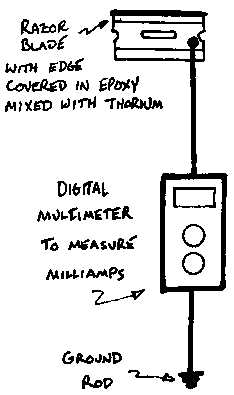This lightning detector experiment uses slightly radioactive Thorium from lantern mantles to help ionize the air around the edge of a razor blade, which is connected to an earth ground. Static electricity from a thunderstorm will flow from the ground, up through a milliammeter, and is dissipated into the storm through the razor blade. We were recently informed by a kind reader that Coleman® no longer uses Thorium in their mantles! So try mantles by other companies...Alladin® mantles still use Thorium and work great for this experiment. Another suggestion we received was to use the Americium-231 sample from an ionization-type smoke detector as the radioactive source, with a steel needle pointed right towards it with a very small air gap. PLEASE NOTE that there are many more dangers involved with the Americium-231 method than when using lantern mantles, which are fairly safe! Americium is a bone-seeker, and could permanently poison you. Check out the Americium lightning detector thread on our discussion board. Be sure you are a sane, sober adult before attempting to take a part a smoke detector.
There are other ways to make a sensor that don't need any radioactive elements. Other readers have reported success using just the razor blade, an array of needles, aluminum foil sheets, etc. For an extremely sensitive detector, you might try googling up a 'field mill,' which is used by lightning researchers. A commercial version would be very expensive, but it's possible to homebrew such a device.
As static builds up before a lightning strike, the milliamp reading will increase until the lightning flashes and equalizes the electrical potential between earth and sky. At this time, the meter reading will drop to zero or negative, and then build up again until the next strike. It is possible to predict how close to you lightning will strike by observing current readings and counting the seconds between the lightning and thunder. The lightning detector, IN THEORY, could actually help prevent a lightning strike near it by dissipating static electricity, the same principle used in static discharge arrays that protect tall structures like antennas and windmill towers. IN FACT, this detector is much too small and does not dissipate enough current to have any effect on preventing lightning strikes--we simply want to get the principle across. A reader described it as 'That would be like thinking you could steer a tornado away from your house by waving a fan at it!' This project should still work without the Thorium from the lantern mantles--sharp metal edges and points will cause a current flow on their own, but the Thorium should increase the response and current flow. If you try this experiment with a plain razor blade, please let us know your results! Another factor that will influence your current readings is the quality of grounding.You Will Need:
- Razor blade
- Multimeter that reads milli- or micro- amps
- Ground rod (use existing house or telephone ground rod, or use a 3-4 foot length of 1/2 inch iron or copper pipe
- Small hose clamp
- 15-20 feet of wire (we used telephone wire)
- 5-minute epoxy
- 1 or 2 Alladin® lantern mantles
- 2 small alligator clips
- First, hold the two lantern mantles over a plate with pliers, and carefully light them on fire. Collect the ash on the plate (and don't breathe any in). Mix up a small amount of 5-minute epoxy, and mix in the ashes thoroughly. Apply this paste all around the sharp edge of the razor blade about 1/16 inch thick.
- While the epoxy is drying, Use the hose clamp to connect your wire from the ground rod to the multimeter.
- Your existing ground rod (located underneath the telephone or electric service entrance box) is the easiest way to do this.
- If you cannot find your ground rod, make one by pounding a 1/2" piece of iron or copper pipe into ground. Use wet ground if possible for a better ground connection. The dripline around your house works very well, but be careful of underground utilities when you drive in the rod.
- When the epoxy is dry, mount the razor blade in a high place. We mounted ours a foot above the eaves on a wooden stick.
- Fasten a wire to the razor blade with an alligator clip, and connect the other end to the multimeter.
- Set the multimeter to measure micro- or milli- amps. Try microamps first--if your reading during a storm exceeds your meter's range, switch to milliamps.
Wait for a thunderstorm
and have fun!
